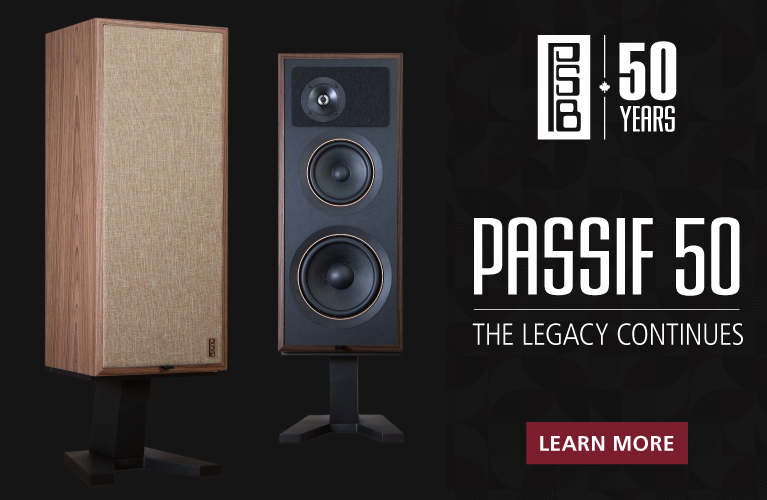After assembling in my listening room the best-sounding stereo system I’d heard anywhere, and writing about it in April, I did something to that extraordinary setup that most audiophiles might find unthinkable: I disassembled it. I needed the room to explore some cutting-edge products with features and technologies that might get me close to the sound quality of that ca.-$150,000 system (all prices USD) for a lot less money. The first of those products was Anthem’s STR preamplifier ($3999), whose extensive features I still haven’t fully explored.
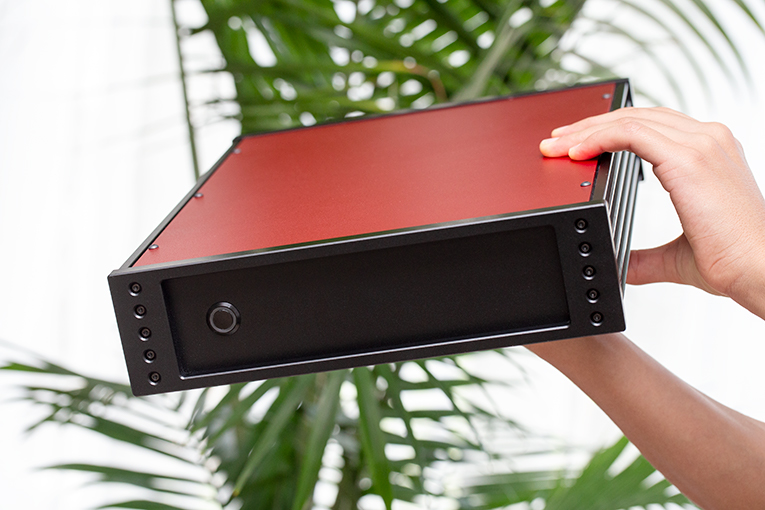
This month, however, I don’t write about products consumers would be likely to buy. Instead, the focus is on Purifi Audio, a Danish concern that supplies components for other audio companies’ consumer products. These include the 1ET400A amplifier module, the PTT6.5W04 6.5” midrange-woofer, and the evaluation kits provided for them. The amp and driver are available to DIYers: at Purifi’s online shop, the 1ET400A sells for 2018 Danish kroner (currently about $300; all prices exclusive of VAT), the PTT6.5W04 for 2329 DKK (about $345). So far, the most prominent company to use a Purifi part is NAD -- the 1ET400A forms the amplification heart of NAD’s new Masters Series M33 integrated amplifier-DAC, which should make it to store shelves this month for $4999.
Why Purifi?
I first got interested in Purifi’s products last November, at Warsaw’s Audio Video Show 2019, when I had coffee with Peter Lyngdorf. Lyngdorf is Denmark’s -- perhaps the world’s -- most prolific hi-fi entrepreneur, known for his HiFi Klubben chain of over 100 stores in Denmark, Germany, the Netherlands, Norway, and Sweden; his founding of manufacturers DALI, Lyngdorf Audio, and TacT Audio; and his cofounding of Steinway Lyngdorf, a hi-fi-based collaboration with the famous piano maker. At one time or another, Lyngdorf has owned Gryphon Audio Designs, NAD, Snell Acoustics, and probably other companies I’m not aware of. Now he can add to his résumé “cofounder of Purifi Audio.”
 Peter Lyngdorf
Peter Lyngdorf
But despite Lyngdorf’s extensive background in audio, when he brought up Purifi -- at the time, I knew little about the company -- he spoke so excitedly I could have sworn it was the first business he’d ever started. “The Purifi amp is so good, you no longer have to talk about quality!” he declared. “There is no harmonic distortion, no intermodulation distortion, no frequency-response aberration, regardless of frequency or load. It’s better than any other amplifier!”
I was taken aback. “Do you really mean any amplifier, of any type -- class-A, class-A/B, class-D, class-whatever?”
His excitement was undimmed. “Yes!”
According to Lyngdorf, Purifi’s technological breakthroughs have resulted from the synergy between Lars Risbo, who designed highly regarded switching amplifiers for TacT and then went on to work for Texas Instruments, and Bruno Putzeys, who many feel had already defined the state of the art of class-D amplification in the design of his Hypex Ncore amp modules. Combining their efforts, Risbo and Putzeys brought the Purifi class-D amplifier platform further than either could have on his own.
When Lyngdorf and I had coffee, it wasn’t clear to me if the PTT6.5W04 driver was finished, but Lyngdorf sounded as excited about it as he was about the amp module. He told me how the Purifi team had looked at every aspect of the transducer’s design and, through exhaustive and innovative measurements, discovered previously unsuspected causes of distortion that they were then able to address. He also mentioned that the driver would be like nothing else I’d seen. I found out later that he wasn’t kidding.
But already, by the time we’d drained our coffees, I knew I had to learn more about Purifi -- and hear their products.
Some background
I learned that Risbo, Putzeys, and Lyngdorf originally began working together in the interest of pure research. But when they came up with something unique to offer, Purifi Audio became a bona-fide commercial entity -- as did its subsidiary, Purifi Transducer Technology. With that expansion, Carsten Tinggaard and Claus Neesgaard, who also have admirable histories in hi-fi, joined the team as co-owners. According to Neesgaard, managing director of both firms and the person with whom I most often corresponded, the distinction between the two entities isn’t important: “To the outside world, we operate under just one name: Purifi.”
What’s important for our readers right now is not the Purifi team’s past accomplishments, but what they hope to achieve with the 1ET400A amp, the PTT6.5W04 drive-unit, and other amp modules and transducers they plan or have already launched. There are as yet no other amp modules, but there are three other transducers: the 4” PTT4.0W04 and higher-impedance 6.5” PTT6.5W08 drivers, and the 6.5” PTT6.5PR passive radiator. According to an e-mail from Putzeys, Purifi’s goal for its amplifiers is this:
We’re hoping to turn “flawless” amplification into a commodity. It’s a straightforward technical function that everyone needs. The constant reinvention of wheels is a perennial distraction. It’s the main reason why audiophiles are having to put up with clunky high-maintenance hi-fi towers while everyone else just hits play or asks Alexa to do it for them. If manufacturers of high-end audio equipment feel confident that they can just buy the best possible amplification as a standard block, they can concentrate on what else their products need to do to make listeners happy.
Risbo had this to say about Purifi’s transducers:
Our PTT6.5W04 woofer is the result of about four years of research combining the strength of a whole team of sharp minds. While only the surround appears to be divergent, the entire design is in fact vastly different from conventional drivers. During the design process we were dead set on identifying and removing all sources of intermodulation distortion (IMD), as our ears are much more sensitive to that as compared to the traditionally discussed harmonic distortion. In short, this required us to remove all nonlinear mechanisms in the transducer.
Nonlinear Bl (i.e., position-dependent force factor of the motor system) is a well-known source of IMD, so we have made this ruler-flat. Less known is the current- and frequency-dependent modulation of the force factor, which we have reduced by up to 40dB over conventional transducer designs. Furthermore, we significantly reduce the position-dependent inductance that causes a modulation of the drive current. We developed a new surround geometry to combat the varying radiating area of conventional surround designs and were able to reduce this issue by orders of magnitude. Finally, we managed to reduce hysteresis distortion by up to 50dB compared to industry benchmark drivers -- ridding our transducers of an extremely annoying distortion mechanism that leads to non-dynamic sound and lack of “black canvas.”
1ET400A and Eigentakt
Purifi’s 1ET400A is a class-D amplifier module on a single circuit board measuring only 2.48”W x 1.30”H x 3.23”D. It’s monaural -- you need two for stereo -- and pretty powerful, with a claimed output of up to 425W into 4 ohms, with not more than 1% total harmonic distortion (THD). At 100W output, though, it’s more impressive: THD is specified as only 0.00017%, 20Hz-20kHz, which is below the measurement threshold of most audio analyzers. It’s also claimed to be impervious to load, which not all class-D amps are -- some show variation from flat frequency response in the top octave of the audioband, depending on the load.
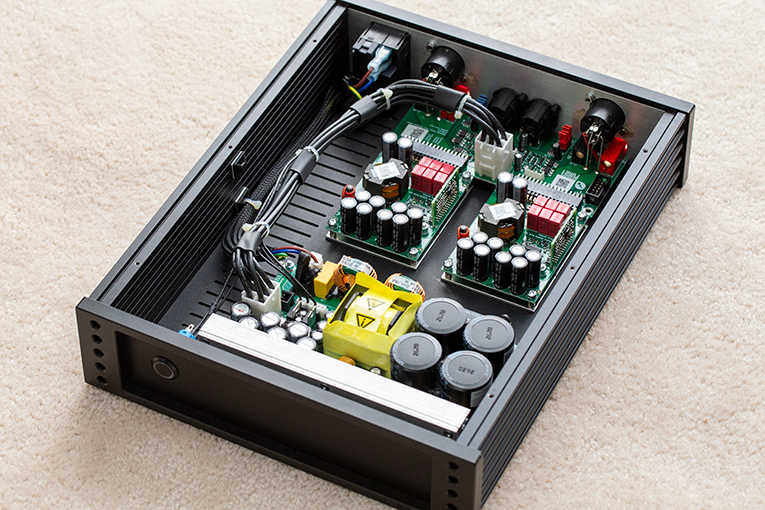 Inside the Eigentakt
Inside the Eigentakt
There’s a slight catch: The 1ET400A is only an amplifier module, and provides just 13dB of gain -- far less than the 28dB typical of most power amps. As a result, it needs an additional gain stage in front of it to mate well with most hi-fi preamps, as well as a power supply -- in short, you can’t evaluate an 1ET400A on its own. Because of that, Purifi created the Eigentakt stereo amplifier, which they send to companies that are considering using the 1ET400A in their own products; the Eigentakt (German for “self-clocking”) is also what they sent to me.
The Eigentakt weighs just 12 pounds, has a black metal case measuring 10”W x 2.75”H x 12.5”D, and looks like something you’d build from a kit. (A red top plate dresses it up a bit.) Inside are two 1ET400A boards attached to Purifi’s FE02 gain-stage board, which provides another 14dB of gain, to raise the entire system’s output to an acceptable 27dB. For those who want to evaluate only the amp modules, the gain circuitry can be bypassed via DIP switches on the FE02 board. Still, the FE02 itself includes many things I wanted to try: left and right balanced (XLR) analog inputs, left and right Neutrik speakON jacks for the speaker cables, and, on the front panel, a Standby button. The Eigentakt’s only non-Purifi circuitry is a switching power supply courtesy Hypex, which Putzeys likely designed when he worked there.
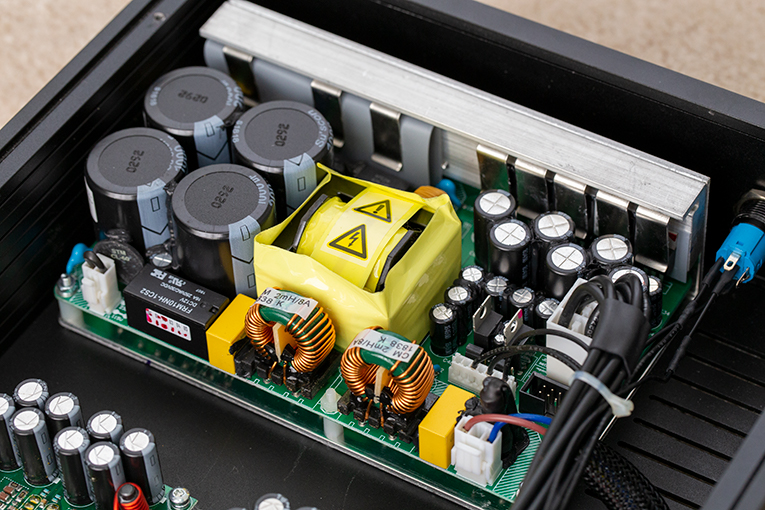 Hypex power supply
Hypex power supply
Companies that use the 1ET400A are expected to provide their own gain stage, power supply, connectors, etc. -- but, as you’ll read below, I found that the Eigentakt with FE02 worked so well that I couldn’t help wondering if some manufacturers might end up using the whole thing after all. When I asked Neesgaard about that, he replied: “We get more and more requests for also selling the FE02 in bulk and not just as part of the evaluation kit -- so this is something we are looking into.”
It looks as if they’ve gone ahead with it, at least for small batches. Purifi’s online shop recently added a package deal of an FE02 and two 1ET400As, called EVAL1, for 4775 DKK (about $700), or 4515 DKK (about $664) if you buy four or more sets. But I wonder how a company that might include the FE02 with the 1ET400As will differentiate itself from other companies doing the same.
PTT6.5W04 and SPK5
Purifi’s SPK5 two-way minimonitor, of which I received a pair, is to the PTT6.5W04 drive-unit as the Eigentakt amplifier is to the 1ET400A: a basic platform designed to showcase a Purifi part. Also like the Eigentakt, which relies on a Hypex power supply, the PTT6.5W04 is paired with a non-Purifi part: Mundorf’s AMT21CM2 tweeter, an air-motion transformer (AMT). (Purifi doesn’t yet make a tweeter.) That tweeter is positioned off-center on the front baffle -- the speaker is sold in mirror-imaged, or “handed,” pairs. In most cases, the SPK5s should be set up with their tweeters closer to the speakers’ inner side panels.
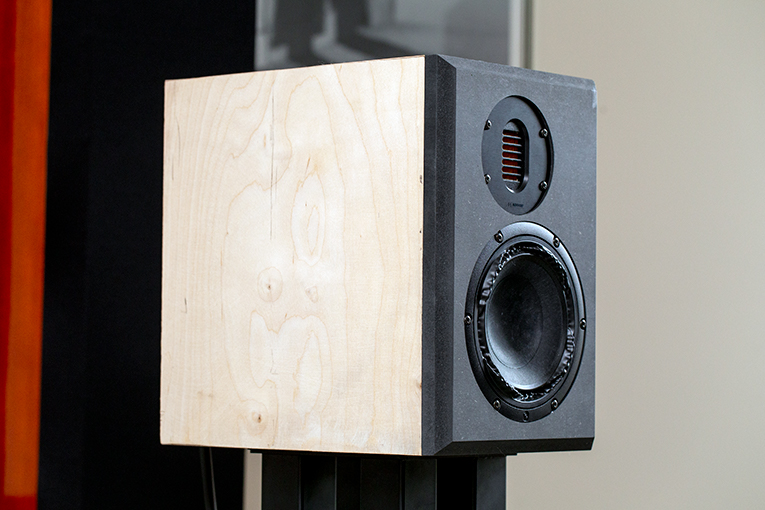 SPK5
SPK5
The drivers hand off to each other at a high frequency of 3.2kHz -- in an e-mail, Claus Neesgard told me that the crossover frequency in Purifi’s preceding evaluation model, the SPK4, was only 2.5kHz: “[W]e found out that the PTT6.5W04 actually performs better (lower distortion) in the crossover region than the Mundorf AMT.” The crossover itself is external, its circuits on 1/2”-thick, gray-colored fiberboard, with caps, inductors, and resistors from Denmark’s Jantzen. Purifi kept the crossover separate so that companies that want to test the drivers independently, or with their own crossover, can easily do so.
The SPK5’s cabinet measures 13.375”H x 9”W x 13.375”D. The front baffle is made of 1”-thick MDF with chamfered edges, the other panels of 0.83”-thick unfinished birch plywood. It’s just a crudely made box, but it does the trick in providing a way to test the entire speaker, as well as the individual drivers, in an appropriately sized enclosure. Like the Eigentakt, the SPK5 has a speakON input jack on its rear panel, just below the port; the external crossover, too, has speakON jacks for input and output.
 SPK5 external crossover
SPK5 external crossover
The first time I got a really good look at the PTT6.5W04 driver was when I pulled an SPK5 from the cardboard carton in which both speakers were shipped. My first thought was, What the . . .? I suspect many others will have a similar reaction.
From the front, the PTT6.5W04 looks as if someone ran a blowtorch around its surround and melted it into a series of bumps and divots. It looks odd enough that some might find it off-putting, which could make it a difficult sell, especially for an audiophile speaker likely to be used without a grille. Purifi calls this their Neutral Surround, and claims that it’s done to avoid the deformations produced by a conventional surround as it moves, in turn reducing harmonic and intermodulation distortion. I asked Claus Neesgaard about it. “It’s not just the cone that moves air,” he wrote back. “The moving part of the surround also makes sound. But a classical roll surround doesn’t deform uniformly: how much of it follows the cone depends on the position. It’s as if the cone grows and shrinks with position. The Purifi surround distributes the movement evenly over the entire surround surface.”
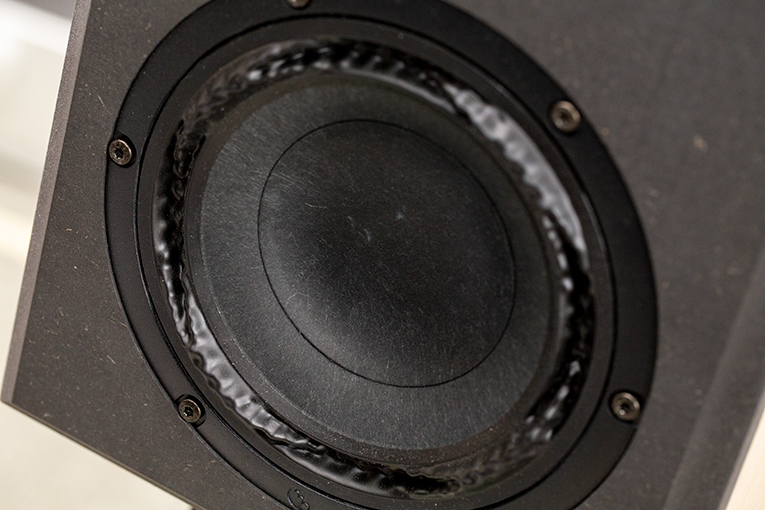 PTT6.5W04 midrange-woofer
PTT6.5W04 midrange-woofer
The driver’s basket, spider, and motor system don’t look nearly as odd, and neither does the concave cone of paper and fiber. But as Lars Risbo said in his e-mail to me, the suspension and motor system include numerous innovations to reduce various types of distortions. The most interesting to me has to do with distortion caused by the metal in the motor system, which Purifi calls the “classical Achilles’ heel of long stroke drivers.” Their solution is their Force Factor Modulation, which they wrote about in a 2016 AES paper, “Force Factor Modulation in Electro Dynamic Loudspeakers.”
This sort of distortion is easily revealed in measurements of a speaker’s total harmonic distortion (THD), such as the ones we do at Canada’s National Research Council (NRC). When a driver suffers from this kind of distortion, we see its THD rise significantly somewhere in the lower midrange (i.e., below 1kHz). Exactly how Purifi has addressed this problem in the PTT6.5W04 isn’t clear to me, but they say that their process is unique. Risbo is confident that we’ll see no distortion of this type when we measure the SPK5 at NRC.
Speaking of speakONs . . .
When I unpacked the Eigentakt and SPK5s and saw the Neutrik speakON connectors used throughout, I was relieved that Purifi had also sent a package that included the speakON-terminated cables needed to connect the Eigentakt to the SPK5s’ external crossovers and the crossovers to the speakers, as well as a set of cables terminated with speakONs at one end and banana plugs on the other, for connection to other speakers. Purifi makes these cables themselves, using CLS 425 bulk speaker wire made in Germany by Cordial.
Purifi’s reliance on speakONs intrigued me, so I asked them about it. Lars Risbo:
Nearly all binding posts and/or banana plugs available we found to be magnetic and added measurable hysteric distortion. The cheapest plastic speakON passed the test. It seems that Benchmark Media Systems came to the same conclusion with their very low distortion AHB2 amplifier.
Moreover, we run biwiring through the crossover filter to the speaker box. Using the four-pole speakON, we can join the branches right at the amplifier’s sense point, where the output impedance is extremely low. This effectively blocks leakage of distortion products between the drivers. This makes biwiring actually work.
Listening: Eigentakt alone
My first project was to evaluate the 1ET400A and PTT6.5W04 by listening to and measuring them. But because each can function only as part of a system -- respectively, the Eigentakt and SPK5 -- that includes other components, I could evaluate each only within the context of its system. There’s no way around that limitation. It’s also important to remember that when an audio company uses the amp module or driver in their products -- and assuming they don’t just duplicate Purifi’s Eigentakt and SPK5 -- that company’s final products will perform differently from what Purifi sent me. But this doesn’t render my evaluation process fruitless -- the Eigentakt and SPK5 provide benchmarks for how the Purifi company thinks their products should be used.
I began evaluating the Eigentakt when I used it in May to review the Magico A1 minimonitors ($7400/pair). Before hooking up the Eigentakt, I’d been using a pair of Constellation Audio Revelation Taurus monoblocks -- massive amps that cost $40,000/pair, are specified to each output up to 500W into 8 ohms or 1000W into 4 ohms, and sound outstanding. The Eigentakt clearly wouldn’t be able to match that kind of power, but the Magico A1s don’t need it -- and don’t want it, unless you want to blow them up.
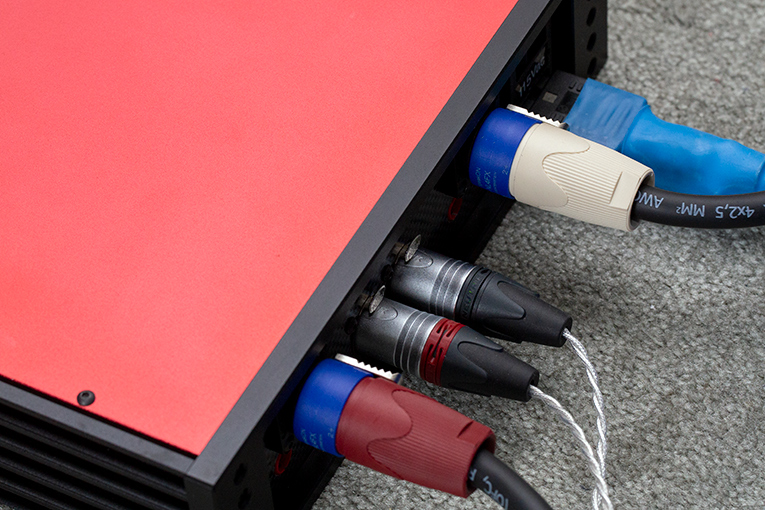 Eigentakt back panel
Eigentakt back panel
I also swapped out the Nirvana S-L speaker cables I use with the Constellations for the Neutrik speakON cables supplied by Purifi. Feeding the Eigentakt were an EMM Labs DA2 Reference DAC and Pre preamplifier, both via Crystal Cable Standard Diamond Balanced interconnects. My music server was an Asus ZenBook UX303U laptop computer, connected to the DAC with an AmazonBasics USB link.
I found that the Eigentakt was not only powerful enough to drive the A1s -- it sounded as good as the Constellations. As I wrote in my review, “almost nothing about the A1s’ sound had changed -- the tonal balance was the same, the highs were just as extended and the midrange just as pure, voices were equally robust, bass just as extended, and the soundstaging and imaging were exactly as before.” What’s more, I also thought that if there were any differences in the sounds, they “were at best slight and, surprisingly, favored the Purifi.” I played “Hope Is a Dangerous Thing for a Woman Like Me to Have -- But I Have It,” from Lana Del Rey’s Norman Fucking Rockwell! (16-bit/44.1kHz FLAC, Interscope). As I also said in the review, “the subtle sounds of her lips moving as she sings softly into the microphone were more apparent through the Purifi.” Ever since the arrival of the Revelation Taurus monos, I’ve loved their combination of smoothness, detail, and effortlessness -- for the Eigentakt to turn in the same performance, at a fraction of the price, was incredible. I was impressed. Granted, if I’d needed more power than the Eigentakt could provide, the Constellations would have easily walked away with the prize -- but in this first test, and within the Eigentakt’s power limitations, its sound quality had proved extraordinary.
Nor did the Eigentakt functionally disappoint. When I first turned it on, by flicking the main power switch on its backside and pressing Standby on the front panel, I heard no trace of noise or hum from the speakers. The ring around the Standby button glowed red, but still I wondered if the power was on. I held one ear close to the tweeter of one A1 and heard only a faint hiss. At that point, the EMM Labs DAC and preamp were also in circuit and powered up -- when I turned them off, the hiss got even fainter. I had to put my ear almost on the tweeter to hear anything at all. The Eigentakt is one quiet amp.
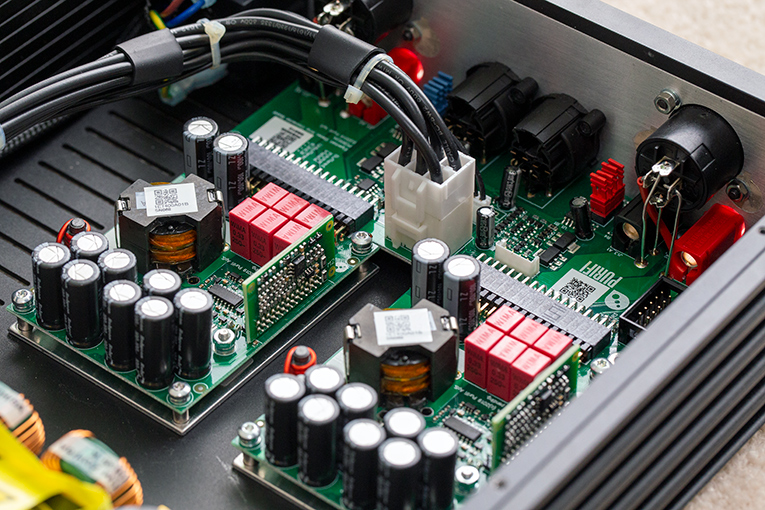 FE02 and 1ET400A modules
FE02 and 1ET400A modules
After completing my review of the Magico A1, I traveled to the UK to shoot some videos for our YouTube channel, and lent the review sample of the Eigentakt to fellow reviewer Diego Estan, who hooked it up to his McIntosh Laboratory C47 preamp-DAC ($4500). Diego had exactly the same experience I had. When he first powered up the Purifi and Mac, he was startled to hear only a faint hiss from the tweeter of one of his Focal Sopra No1 speakers -- a hiss that grew fainter still when he switched off the preamp. Diego admires superquiet components -- he really liked that aspect of the Eigentakt.
He then compared the Eigentakt to his McIntosh MC302 stereo power amp ($5500, 300Wpc into 8, 4, or 2 ohms), and found them sonically indistinguishable -- their tonal balances were identical, and he didn’t think he heard any more or less detail with either. When he e-mailed me about this, I wrote back asking him to play the same Lana Del Rey track I had. He did, and again the amps sounded exactly the same. Diego wasn’t let down at all. He feels that his McIntosh MC302 sounds as transparent as an amp can, and was excited to find a tiny, inexpensive amp that could equal its performance. “The Eigentakt is an ideal amplifier,” he wrote back: “small, light, powerful, ultraquiet, and completely transparent.”
Listening: Eigentakt and SPK5
Back in Ottawa from the UK and under COVID-19 lockdown, I had all the time in the world to test the Eigentakt and SPK5s together. My Asus ZenBook UX303U laptop was still my music server, but now, instead of the EMM Labs components, the Anthem STR pulled double duty as DAC and preamp, but with its built-in Anthem Room Correction switched off -- leaving ARC on would have changed the speakers’ frequency response. The system’s wiring remained unchanged, and the SPK5s sat on the same 24”-high Foundation stands I’d used with the Magicos.
This system took a lot longer to get used to, because the SPK5’s sound differed from that of any other two-way speaker I’ve heard. My ears had to acclimatize to them.
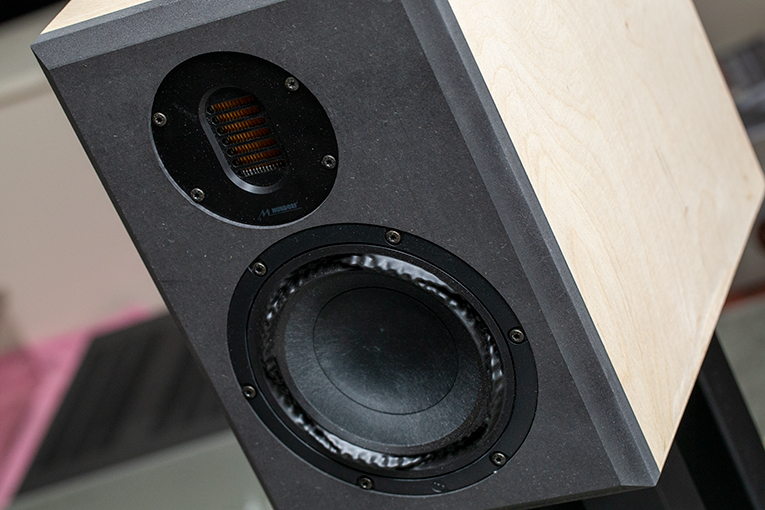
As I skipped through several of the deepest-bass tracks on the Cowboy Junkies’ The Trinity Session (16/44.1 FLAC, RCA), I noticed that the SPK5s could reach down to about 30Hz with just enough energy, which made their sound remarkably full for their small size. That low end also had some power -- Peter Timmins’s drumming in “Sweet Jane” had the impact of a floorstander, not a minimonitor.
From there, Selena Gomez’s Rare (16/44.1 FLAC, Interscope/Tidal) provided a stark contrast in recording technique -- Rare boasts a plethora of synthesized instruments, no sense of a natural acoustic, and a steady onslaught of deep, powerful bass that could stress a smallish midrange-woofer. But not Purifi’s PTT6.5W04 -- at typical listening levels, its reproduction of the low end down to about 30Hz was, again, clean and forceful, and the midband and highs were so strikingly clear and clean that I nudged the volume higher than normal.
I also learned that, when pressed, the SPK5s could play very loud without strain. I cued up Michael Bublé’s medley of “It’s a Beautiful Day” / “Haven’t Met You Yet” / “Home,” from Bublé! Original Soundtrack from his NBC TV Special (24/48 FLAC unfolded to 24/96 MQA, Reprise/Tidal), and set the volume on the Anthem STR to -30dB, which produced an above-average volume level in my room. I was able to go as high as -20dB before I got the first hints that I shouldn’t go much higher. I could feel the sound getting too loud for my ears, and it was resonating too much in the room. Still, the speakers seemed to be holding together well, and unlike the Magico A1s, which compressed even at lower volumes, it seemed as if the SPK5s could go even louder. I nudged the STR’s volume up to -17dB and, using the Sound Meter SPL meter on my Samsung S10 smartphone, registered a maximum volume level of 97dB at my listening seat, 9’ from each speaker. At 4.5’ from both speakers the maximum SPL hit 100dB, which is LOUD and potentially ear-damaging -- according to the CDC’s website, permanent hearing loss can result from being subjected to sound at this level for 15 minutes.
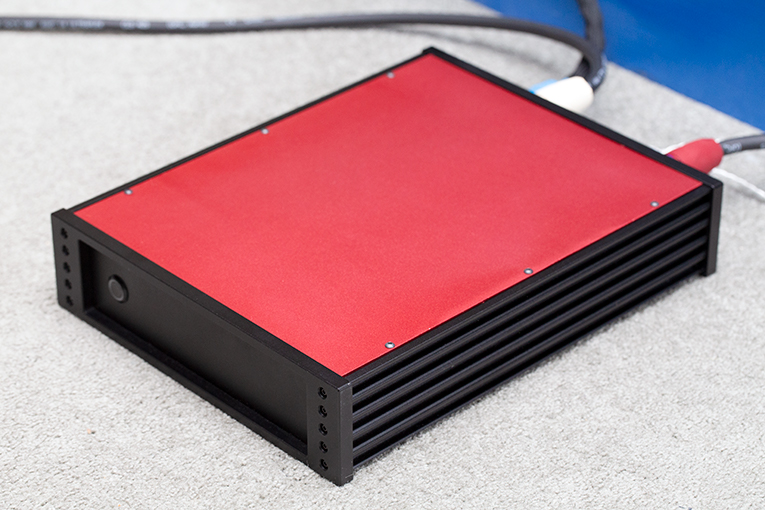
I repeated the test with “Don’t Stop Believin’,” from Journey’s Greatest Hits (16/44.1 FLAC, Columbia/Tidal), which is heavily compressed, bass-shy, and overabundant in midrange energy. My SPL meter registered the same peaks of 97dB at my listening seat and 100dB halfway toward the speakers, whose drivers -- Purifi midrange-woofer and Mundorf tweeter -- both still sounded fine. Still, it was too loud for my ears, too resonant in the room, and far beyond what anyone would want for serious listening. I cut it off there, though I could probably have pushed the speakers further. But just before I did, I laid a hand on one side of the Eigentakt. It was merely warm.
I then listened more critically, at saner volume levels, to the SPK5s, and found their midrange extraordinarily detailed -- voices really came alive. Even microscopic subtleties were now not only obvious, but likely contributed to the incredible soundstage depth I heard. For example, when I played “Mining for Gold,” from the Cowboy Junkies’ The Trinity Session, Margo Timmins’s voice, up front at center stage, hung rock-solid between the speakers with amazing presence. Her aural image wasn’t tightly focused, nor should it be -- engineer Peter J. Moore miked her closely, to make her voice sound immediate and very full, with lots of air around it. He also wanted the listener to hear the echoing of her voice from the walls of the Church of the Holy Trinity, in downtown Toronto. In my room, the image of Timmins was about 2’ wide, rock solid between the speakers; the surrounding air went another 3’ in every direction; and those echoes seemed to ricochet off the walls 50’ away, the intimate sound of her voice in bold relief against the cavernous sound of the recording venue.
If you’re getting that kind of spatial information, it means that the speaker’s individual drivers are working well together -- clearly, the SPK5’s drivers were. There were no hints of where the bandwidth of the midrange-woofer stopped and the AMT tweeter began. But for a while there, I wasn’t sure that the highs didn’t sound just a bit too polite -- they weren’t giving me that more in-your-face sound I’ve heard from such recent two-ways as Focal’s Kanta No1, which I reviewed in July 2019. It wasn’t until I streamed Lang Lang’s Piano Book (24/28 FLAC unfolded to 24/96 MQA, Deutsche Grammophon/Tidal) and concentrated on the contrast of his higher- and lower-register keystrokes that I realized the SPK5s were getting the upper frequencies just right -- from top to bottom, the speaker’s sound was neutral. This impression was reinforced when I listened again to Rare -- Selena Gomez’s voice is recorded a little hot, and a speaker with elevated treble would give her voice too much sizzle. That said, if someone said they’d prefer a bit more sparkle up top -- maybe a dB or two of lift at the top of the audioband -- I wouldn’t be surprised. Some people like slightly brighter sound than this speaker provides.
The SPK5 did have one flaw. I consistently heard a bit of congestion in the lower midrange, somewhere between 300 and 500Hz. It made what was an otherwise spectacularly clear-sounding midrange just a little unclear. It also destroyed some recordings’ fabulously wide, deep soundstages -- the congestion seemed to be focused at the speaker positions themselves, making it too obvious that their little cabinets were the sources of everything I was hearing. This meant that these speakers couldn’t fully “disappear.”
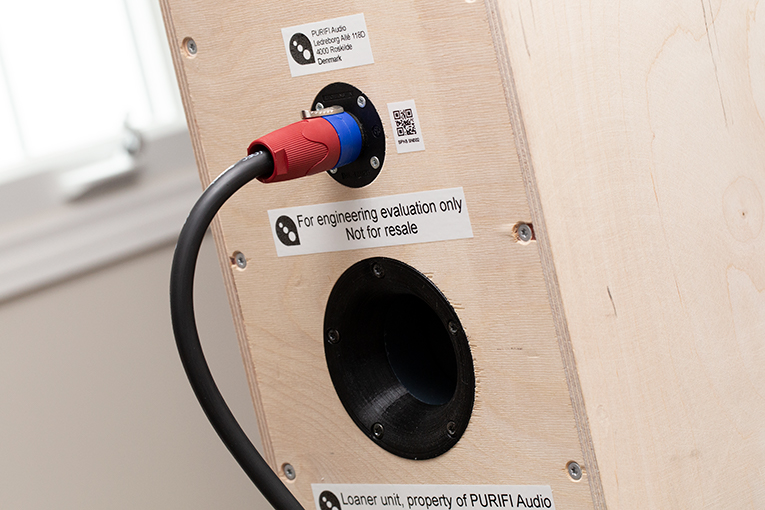
I didn’t know what was causing this until I played the Michael Bublé and Lang Lang albums at fairly high levels, stood close to one speaker with a hand on it, and listened and felt for that congestion. When it appeared, I could feel the speaker’s top, bottom, rear, and side panels all resonating with it. When I pushed the volume higher, the resonances increased. I concluded that the cabinet was creating much, if not all, of the congestion.
But those resonances were really no surprise -- the SPK5’s enclosure is made of birch plywood, but it’s not the solidest-feeling box in the world, and it’s no doubt the weak link in the speaker’s design. If I were a woodworking DIYer, I’d be tempted to stiffen that cabinet, or build a better one to the same basic specs (Purifi provides the schematic), with stiffer materials and/or better internal bracing. It’s easy to imagine many ways someone can improve it, to bring out even more of what these drivers are capable of. But Purifi’s SPK5 is a great start.
One step leads to the next
I was bowled over by the Purifi Eigentakt’s sound and operation. It turned on silently, made almost no noise, provided more than enough power while generating hardly any heat, and passed music through so transparently, at volume levels from low to high, that it left me in near disbelief that so small a box could accomplish so much. Diego Estan had the same experience. In fact, I like the Eigentakt so much that I want to keep it here permanently, to review speakers with and to compare with other amps, particularly those based on Purifi 1ET400A modules. It will be interesting to hear if any of the latter improve on the Eigentakt’s sound.
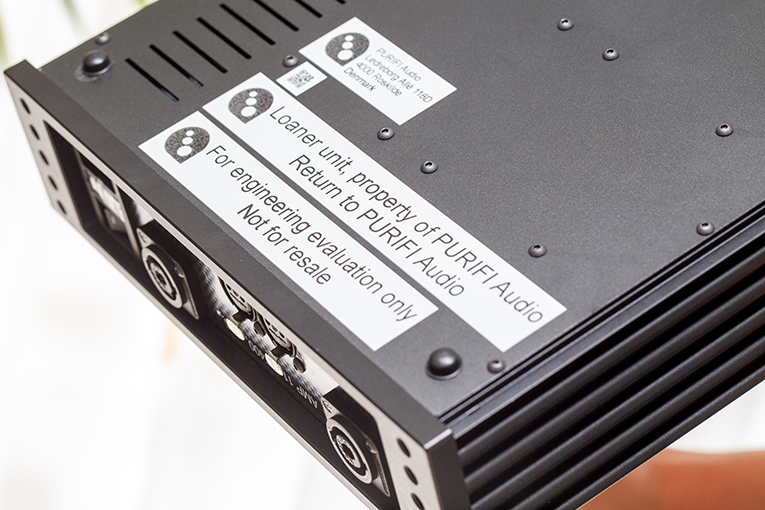
The SPK5 is a different story. Unlike the Eigentakt, which left me with nothing to criticize other than the look and build quality of its case, the SPK5’s sound wasn’t as flawless -- those cabinet resonances need to be dealt with, and I can understand if someone would want slightly brighter highs. But it still ably showed off the qualities of Purifi’s PTT6.5W04 driver, particularly in regard to bass extension, midrange detail, and overall output capability. The SPK5 also displayed the excellence of Mundorf’s AMT21CM2.1 AMT tweeter in terms of its ability to keep up with the PTT6.5W04.
What the SPK5 mainly offers is promise. Though still a work in a progress, the speaker is already a long way along. I’m sure that skilled speaker designers who’ve tried it already have some ideas about what they’d improve on -- not to mention what they might do with the PTT6.5W04 in a loudspeaker of their own design. Just as the 1ET400A has already been recruited for NAD’s Masters Series M33, I expect we’ll soon see Purifi’s strange-looking but excellent driver in new models from many speaker makers.
The next step in this process will be to measure the Eigentakt and SPK5. I’m interested to see if our measurements corroborate Purifi’s specifications, and if they correlate with what I heard. Right now, with the world only beginning to get back on track following the COVID-19 lockdown, I can’t say when that measuring will be done, but I hope to update you here July 1 or, at the latest, August 1.
. . . Doug Schneider
das@soundstagenetwork.com






















